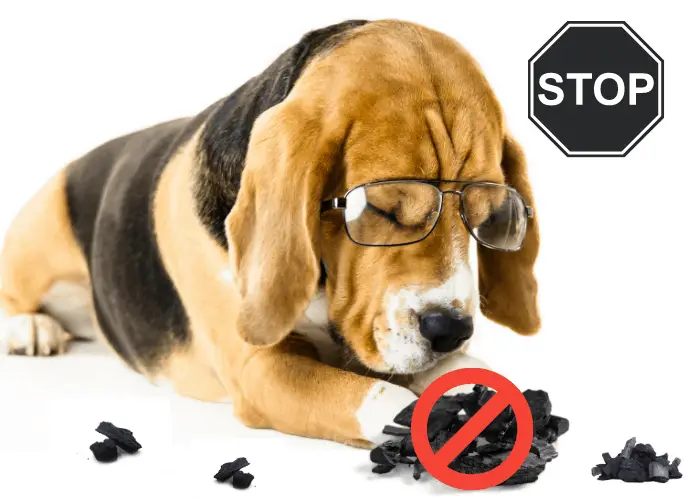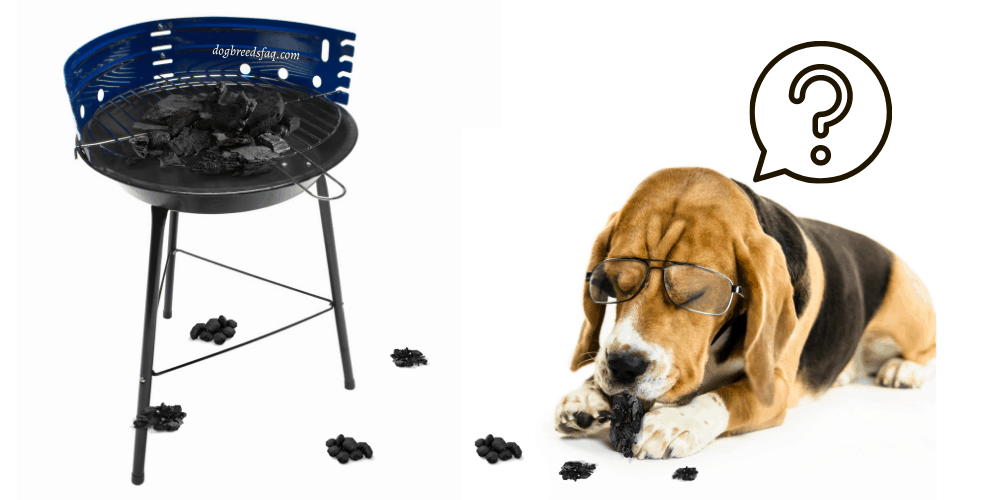We’ve answered some questions about why dogs choose to eat some of the things that they do.
In that same vein, we’re going to answer the question, “Why do dogs eat charcoal?”
This is a common question, which means it’s a common occurrence, so don’t immediately start thinking that something is wrong with the dog.
Dogs eat charcoal because old charcoal might have some of the drippings or fat left on the surface. New charcoal might attract the dog because it reminds them of their food, as there’s a small amount of charcoal in many dry dog food brands for stomach and odor purposes.
Not so normal reasons (or concerning reasons) could be things related to lacking certain nutrients in its diet or even a case of pica.
Pica covers a vast array of issues, but the bare-bones definition of pica is- they feel the need to eat things that they shouldn’t want to eat.
What Can I Do If My Dog Ate Charcoal?

The best circumstances would be that the dog took a couple of bites and found the charcoal wasn’t as tasty as it might have originally thought. This won’t cause any harm to your dog.
But, if for some reason, the dog consumed a good amount of charcoal, it’s best to give your vet a call to get some solid advice. The size, weight, and breed of the dog versus how much it ate will determine whether there will be problems.
However, until you get further instructions from your vet, do not allow your dog to eat any food, but make sure that it has access to plenty of water.
It’s important to do your best to determine how much charcoal the dog consumed as difficult as it may be.
Easy Light Charcoal

Easy light charcoal would be among the worst circumstances, as there are fuels added to the charcoal that makes it easier to light. These fuels are toxic to just about any living thing to consume, no less the dog.
Between the charcoal and the fuel, your dog will wind up with nausea and other stomach issues. As stated above, the severity rests with how much it ate, weighs, the breed, etc.
Tips to Stop Your Dog from Eating Charcoal

Well, the first thing you should do is get the dog away from the charcoal, then remove the charcoal from the area. If it’s finding a way into the bag, find a new home for it.
Alternatively, invest in a container to dump the charcoal into that would be too much of a challenge for your dog to break into.
That will take care of the problem if it’s getting into the bag. A Rubbermaid covered trash bin is a popular choice.
What about dumped charcoal ashes?
One thing you could do is spread it around and mix it with the dirt rather than leaving it in a pile. If it’s scattered well enough, there won’t be much that the dog will be excited about concentrating on.
But if they continue, mix the ashes and spent charcoal up with something they don’t like. Most dogs hate the smell and taste of apple cider vinegar. It’s used as a popular tool against unwanted chewing.
What Happens to a Dog After Eating Charcoal?

If the dog eats a small amount of plain charcoal relative to its size, the worst that can happen would be an upset stomach. Most dogs wouldn’t show any signs of having any issues at all.
Suppose the dog winds up eating charcoal that’s preloaded with lighter fluid. In that case, it can cause problems such as sores in its mouth or around the mouth, weight loss, difficulty breathing, tremors, dizziness, and vomiting.
Another concern isn’t how much charcoal the dog has eaten, but whether it was chewed properly. If a dog doesn’t chew it up but swallows it whole or in large chunks, +the chunks can create blockages in the intestines.
When this occurs, the dog will vomit every time it eats or drinks and won’t pass any stool. This can be an enormous concern for the dog, so it would be wise to keep tabs on your dog for a couple of days after you’ve caught it in the charcoal.
Why is Charcoal in Dog Food?

The short answer is that it helps dogs out to relieve bloat and excess gas.
It’s been found that a small amount of charcoal is good for dogs, which is why it is used in certain brands of food.
However, the charcoal used in food undergoes a process that changes it to what is called “activated” charcoal.
Activated charcoal is created by first, grinding the charcoal into a fine powder. It then gets treated under extreme heat, which changes the molecular structure. This change increases the surface area of the powder and makes it a better candidate for adsorption.
Final Thoughts

The things that a dog can find interest in can baffle the mind. Fortunately, in this case, dogs and charcoal can be easily kept separated.
All it takes is a little forethought and the assumption that if your dog can, it probably will, get into things that you’d rather it stay away from. And if it does get into it, chances are good that the dog won’t eat it past a taste test or more than a couple of nibbles.
That said, if it does eat some, find out how much, and keep your eyes peeled on its behavior for the next few days.
RELATED ARTICLE: Can dogs eat Splenda?

